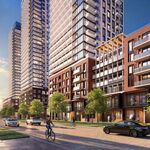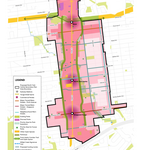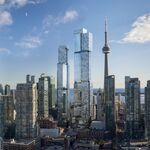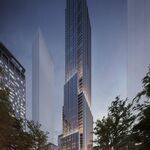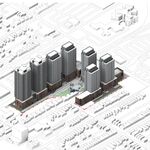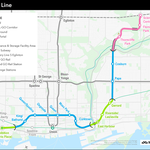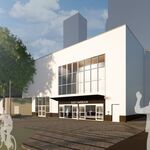Scott Dickson wants to pitch you an exciting idea that he calls, Ontario Place Redux. Imagine having a 'Caribbean' style waterpark at Ontario Place, coupled with the creation a 60 acre, floating, car-free, village over Lake Ontario. Dickson says the technology is there. But can a city like Toronto find it in itself to embrace such a radical vision?
Dickson—best known on UrbanToronto as member '3Dementia', and for his skyline renderings of the Toronto skyline—is one of UrbanToronto's longtime stalwarts, whose daytime job is as the creative director at Upside-Down Marketing and Design. Ontario Place Redux (OPR) is a conceptual plan by Dickson to both make Ontario Place a hot destination spot for the city, as well as to introduce a new neighbourhood nearby to support its activities and functions.
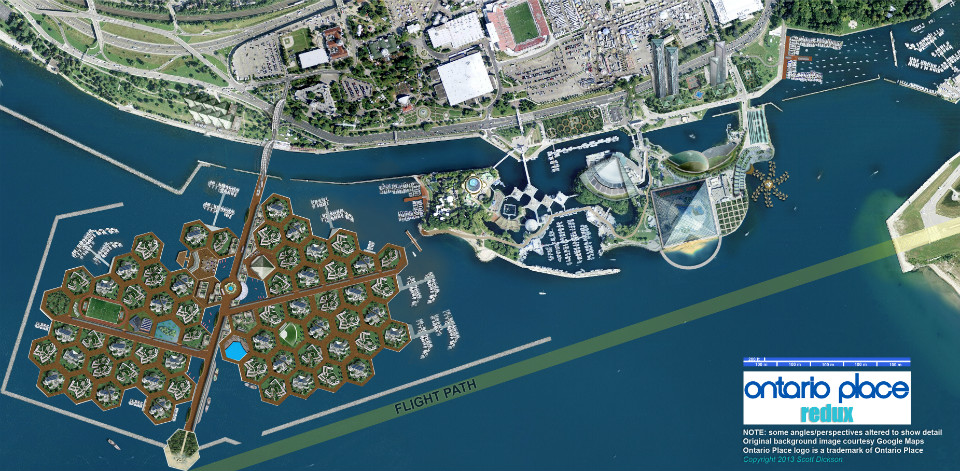 Ontario Place Redux master plan - copyright 2013, Scott Dickson -
Ontario Place Redux master plan - copyright 2013, Scott Dickson -
“I’ve been thinking about the state of Ontario Place, and the whole notion of it potentially lying fallow and not being reinvigorated for a long time because of its link to Exhibition Place, and I started thinking about very practical things that could be done on the site itself, but also a strategy that would help bring it into the city grid as opposed to being only an amusement park you’d get to by car. I was inspired by Eberhard Zeidler’s Harbour City plan. Ontario Place was the only component that got built out of that… I got to thinking about living on the water, and the whole notion of what that area would be like if there was a community, rather than it just being a destination - which it no longer is unfortunately.”
Dickson describes himself as being a “wannabe urban planner-slash-architect for about 30 years", with practical experience with development issues in Toronto. He acknowledges that he’s neither a certified engineer nor accountant, but what he might lack in professional accreditation he more than makes up for in enthusiasm and passion—that even managed to break through the flu he was suffering from during the phone interview I conducted with him.
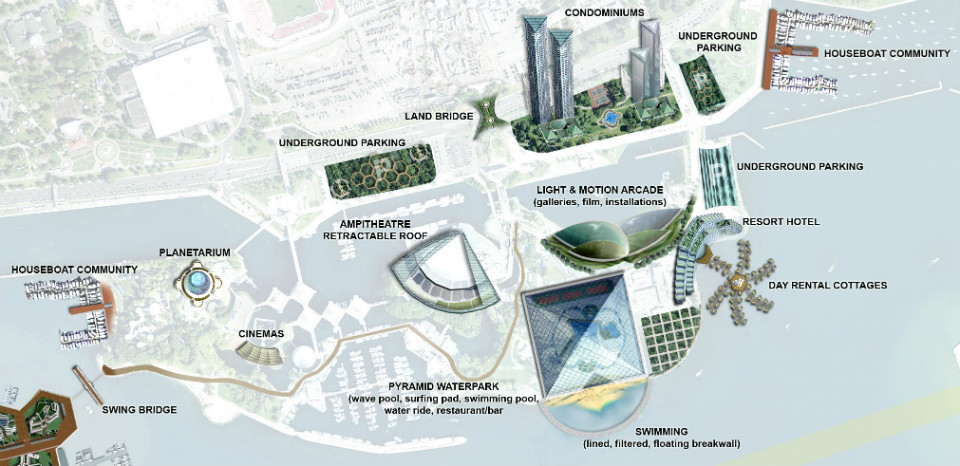 Ontario Place Redux, Ontario Place section "New Elements", copyright 2013, Scott Dickson - LINK TO LARGER IMAGE
Ontario Place Redux, Ontario Place section "New Elements", copyright 2013, Scott Dickson - LINK TO LARGER IMAGE
With Ontario Place, Dickson had four ideas: 1) a glass pyramid waterpark; 2) a resort hotel with day rental cottages on the lake; 3) a 'light, motion & sound' arcade, which is to say a free venue of galleries, exhibits and audio-visual installations "celebrating Toronto and Canadian entertainment heroes", and, 4) a 'Chris Hadfield Planetarium' to make up for Toronto's late and lamented McLaughlin Planetarium which closed in 1995.
Dickson tries to balance activities that would be free or low-cost for families along with more commercial ventures. He suggests reconditioning the existing Cinesphere and Pods, and refurbishing the Amphitheatre into an all year venue with a retractable roof. The northeast mainland of Ontario Place could be used for new condominium development.
“I’ve lived in the [west end of Toronto] for 15 years, and the no-brainer I think—you could conduct a public poll—is that a venue like the [glassed-in] waterpark, given our climate, would be a huge success. The day rental cottage idea is a strategy so families could stage a whole day down there. That’s what you want to encourage; if there’s a place to dump all your stuff. I thought it would be very appealing to families. [The light and sound arcade] is based on a love of music, a love of light, a love of photography, and the basic notion that it would be a great, focused place to tell a modern, accurate story about Toronto.
"I’m obviously a staunch nationalist [laughs]"
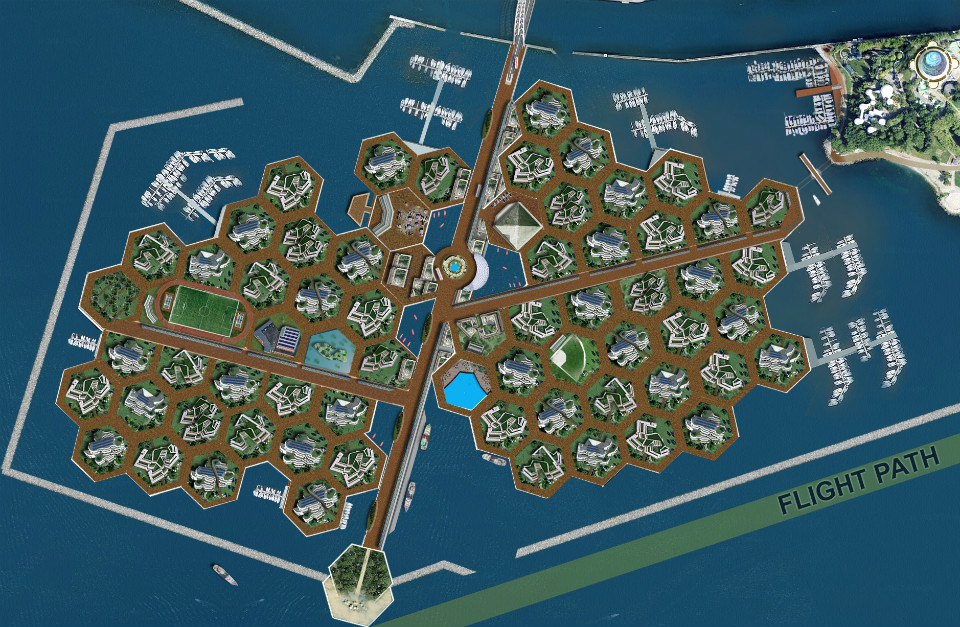 Ontario Place Redux, "Archology Village" section, copyright 2013, Scott Dickson
Ontario Place Redux, "Archology Village" section, copyright 2013, Scott Dickson
An Arcology Village (architecture + ecology) would consist of floating hexagon-shaped concrete platforms that would anchor together to provide a brand new land mass to the west of Ontario Place. A main pier to the artificial island would connect to Dufferin St along with a pedestrian bridge to Ontario Place. While Dickson would leave the design and density of the building up to developers, he imagines that approximately 10,000 people would live in the village.
Underground parking at the north entrance would hide the vehicles, allowing a destination that would instead cater to pedestrians and cyclists. An extended Dufferin bus would be the transit service that reaches the village, additionally allowing utility and emergency vehicles as needed. The transport plan envisions a new off-ramp eastbound onto Lake Shore Boulevard. A retail strip would run through the middle, with residential facilities, including a school and sports fields to the east and west sides of the village.
The Archology Village, if built, would follow in the steps of other floating communities such as IJburg near Amsterdam, Hafen City in Hamburg, and “Boris Island” in London.
“The city lacks vision. Is this the right vision? I’ll leave it to others to decide. Do I believe that Torontonians and people outside of the city would like to live in a village like this? Yes, I strongly believe it would be a huge success. I’ve tried to create a place that would be one-of-a-kind in North America, if not the world. This would be a destination not only for owners and renters, but for all Torontonians.”
 Ontario Place Redux, Ontario Place section, copyright 2013, Scott Dickson
Ontario Place Redux, Ontario Place section, copyright 2013, Scott Dickson
Dickson’s pitch is essentially this: wouldn’t you want to go to a place like that?
The OPR plan may not be not flawless; as the work of one man, the document leaves some questions unanswered. Can the oft-maligned Dufferin bus service an island of 10,000 residents? How do all of Dickson’s ideas for Ontario Place connect together? There’s certainly money to be made here, but when all the lawyers, architects, and two levels of government are brought in, would the political and economic enthusiasm actually be there?
Perhaps the biggest problem with OPR however, is getting people to talk about it. Dickson has sent these ideas to big players like Jennifer Keesmaat, Chief Planner of the City of Toronto, and John Tory, the Chair of the Ontario Place Revitalization Panel, but has felt frustrated at their lack of interest. Thus, to build an audience he has turned to the media, who have been more receptive: “I sent this to Global Television and they came with a camera three hours later.”
Perhaps Dickson’s troubles are rooted in more than government apathy for big ideas. Toronto can often spend a lot of time consulting, fidgeting with minor details on proposals, and trying not to offend the often conflicting sensibilities of politicians, residents, experts, and environmental concerns; big ideas can have a hard time getting traction, no matter who they come from. This is not to suggest that consultation, details, sensibilities, and environmental concerns aren’t important, but instead that sometimes the big ideas get torn up trying to be everything to everyone.
“I spent 30 years in Toronto trying to contribute. Am I entitled to have a vision? Yes… there have been moments of visionary city building. Ye olde CN Tower is a classic example. New City Hall was obviously a pretty bold city statement. Ontario Place itself qualifies even though only a portion of it was put into place. Zeidler’s original design of the forum and the pods in the middle of the lake was pretty revolutionary. What are the odds of this kind of vision taking root in the city with the existing leadership? Slight. Very slight. But I don’t think it hurts to aspire.”
Dickson looks back at the visionary city-building that gave us places like City Hall, the CN Tower, and yes, Ontario Place itself, and asks us to both demand more from Toronto, and to look past the flaws and embrace the big ideas. Because after all…
wouldn’t you want to live in a city that dreamed big?
What to see Scott Dickson's in more detail? Download the PDF here.

 2.9K
2.9K 














